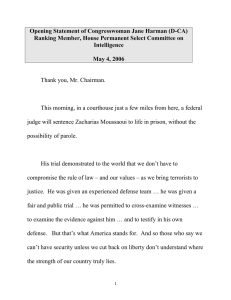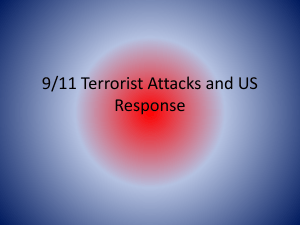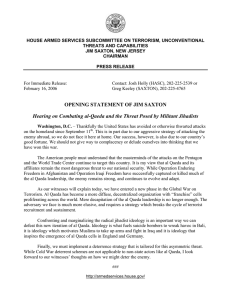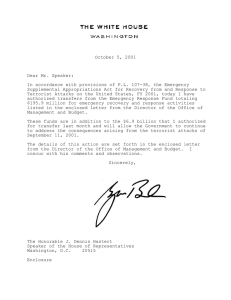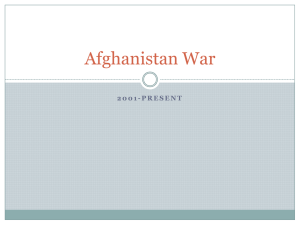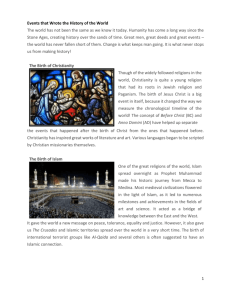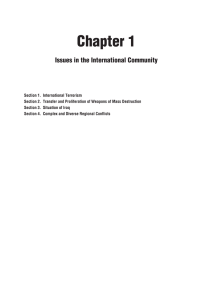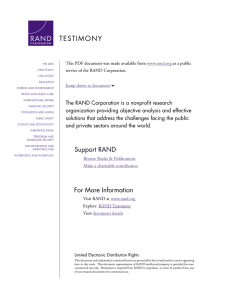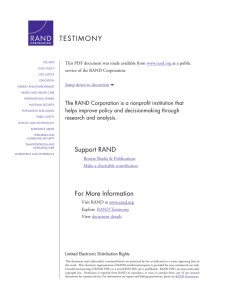Part l Chapter 1 Security Environment Surrounding Japan Issues in the International Community
advertisement
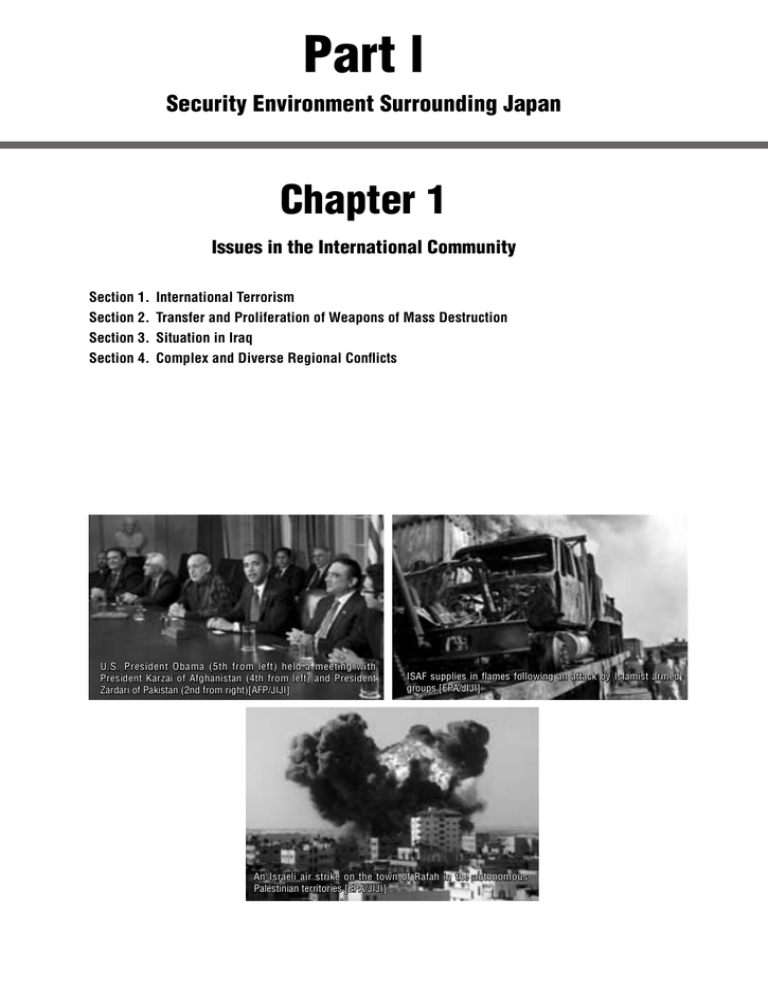
Part l Security Environment Surrounding Japan Chapter 1 Issues in the International Community Section 1. Section 2. Section 3. Section 4. International Terrorism Transfer and Proliferation of Weapons of Mass Destruction Situation in Iraq Complex and Diverse Regional Conflicts U.S. President Obama (5th from left) held a meeting with President Karzai of Afghanistan (4th from left) and President Zardari of Pakistan (2nd from right)[AFP/JIJI] ISAF supplies in flames following an attack by Islamist armed groups [EPA/JIJI] An Israeli air strike on the town of Rafah in the autonomous Palestinian territories [EPA/JIJI] Section 1. International Terrorism 1. General Situation The 9/11 attacks that took place in 2001 prompted the entire world to reaffirm the threat of international terrorism, and became the spark that ignited the current fight against terrorism by the United States and other countries. In the military operation in Afghanistan led by U.S. and U.K. forces shortly after the 9/11 attacks, many of the leaders of Al Qaeda, who were believed to have directed the 9/11 attacks, and the Taliban, who harbored Al Qaeda, were killed or captured. However, Osama bin Laden, Mullah Mohammed Omar and the remnants of their respective organizations are believed still to be hiding in the Afghanistan-Pakistan border region1, and the U.S.-led multinational forces, the Afghan, the Pakistani and other militaries are continuously engaged in clearing operations. It is believed that Al Qaeda today is less capable and effective than it was a year ago, and that it has lost significant parts of its command structure in the Federally Administered Tribal Areas (FATA) in Pakistan2. It is pointed out, however, that Al Qaeda and its affiliates and allies remain dangerous and adaptive enemies and there is the threat that they could inspire or orchestrate an attack on the United States or European countries3. With respect to the relation between Al Qaeda and its affiliates, while the Islamic extremism of Al Qaeda has been spreading throughout the world, the command and control capabilities of the core Al Qaeda group is believed to be declining. There seems to be no clear command and control structure between the core Al Qaeda, its affiliates and groups or individuals inspired by Al Qaeda,s ideology but rather it is a loose network. Therefore, recently, a trend has been seen of Al Qaeda affiliates and local terrorist groups or individuals sympathetic to its ideology conducting terrorist attacks. Al Qaeda affiliates that receive advice from Al Qaeda or those that include “Al Qaeda” in its name perpetrate terrorism mainly in North Africa and the Middle East4; however, it is pointed out that these affiliates have no single format and there are significant differences in the degree of control that the Al Qaeda core can exert over them5. Furthermore, some groups inspired by Al Qaeda ideology are currently a terrorist threat, such as the Madrid train attack group. It was judged, however, there was not sufficient evidence of a direct connection between these groups and Al Qaeda6. 2. Efforts to Struggle Against Terrorism in and around Afghanistan The United States together with other countries has continued military operations against the Taliban and Al Qaeda in and around Afghanistan since October 2001, in the aftermath of the 9/11 terrorist attacks. International operations are also under way in the Indian Ocean to interdict terrorists’ movements and the proliferation and inflow of related goods, such as drugs and arms, which finance their activities. In Afghanistan, attacks orchestrated by the Taliban are increasing, which increases instability, and the future outlook does not allow for premature conclusions. The security situation in the southern and eastern parts, which border Pakistan, is particularly worrying. In addition, there have also been terrorist bombings in Kabul, the capital of Afghanistan, and in the northern and western areas, which were relatively stable and peaceful. Amidst such instability, the Afghan government is trying to improve public security by, for instance, strengthening the military and police. Efforts are also being made by the international community. The Afghan National Army, multinational forces and others are collaborating in mopping-up operations. The International Security Assistance Force (ISAF)7 has set up five Regional Commands under the General Headquarters in Kabul, and provides support for the Afghan government in the maintenance of security in the whole of the country. There are also 26 Provincial Reconstruction Teams (PRTs) to improve the security environment and to conduct reconstruction ― ― Part l Security Environment Surrounding Japan assistance projects in parts of Afghanistan. The United Nations Assistance Mission in Afghanistan (UNAMA) is also continuing its efforts. In Pakistan, which borders Afghanistan, the Federally Administered Tribal Areas (FATA) in the bordering area continue to be an important base for Al Qaeda, the Taliban and a number of other extremist groups, and it is believed that this is where, together with the Taliban, Al Qaeda conducts training operatives, supports attacks in Afghanistan and plans attacks targeting the interests of Pakistan and the West in Pakistan and other countries8. Against this backdrop, the Pakistani government implements terrorist mopping-up operations and other efforts in border areas. President Obama of the United States, who took office in January 2009, is taking a serious attitude toward the struggle against terrorism, as is shown, for example, in the new strategy for Afghanistan and Pakistan announced in March 20099. 3. Terrorist Attacks around the World In Algeria, there were a series of terrorist attacks in 2007 targeting the government and army, including simultaneous bomb attacks on government buildings, the attempted assassination of the President of Algeria, a suicide bombing on the barracks of the Algerian Coast Guard, and bombing of U.N. organizations. Al Qaeda in the Islamic Maghreb (AQIM)10 claimed responsibility for these attacks11. In 2008, there were also terrorist bombings in front of police stations and at police academies. Furthermore, the scope of activities of AQIM has not remained exclusively within Algerian borders, with it being pointed out that the group is recruiting and providing training12 for Islamic extremists in North African countries and plans to expand its mission throughout the entire region and beyond13. In Yemen, besides a terrorist attack in 2008 thought to be targeting the U.S. embassy, a suicide bombing occurred killing some South Korean tourists in March 2009. Both incidents are believed to have been carried out by Al Qaeda affiliates, indicating that the activities of Al Qaeda and its affiliates continue, even after the bombing of the USS Cole off the coast of Yemen in 200014. South Asia has long been suffering frequent terrorist attacks, and India was hit by a series of coordinated terrorist bombings in 200815. In the Mumbai terrorist attack in November 2008, multiple coordinated bombings and shootings occurred in more than 10 places across the city, including hotels, restaurants and stations, killing many foreigners, including a Japanese national. Pakistan has also, experienced a number of terrorist attacks since 2007, including the assassination of former prime minister Benazir Bhutto and attacks by armed groups targeting government and security organizations such as the military and the police. Southeast Asia is still subject to frequent terrorist threats, particularly by Islamic extremists, although some progress has been made in controlling terrorist organizations. Between 2002 and 2005, Indonesia suffered large-scale terrorist attacks, in which the involvement of Jemaah Islamiya (JI), a radical Muslim organization, is suspected16. Since 2006, however, there have been no large terrorist attacks. In 2007 the leaders of JI Zarkasi and Abu Dujana were arrested, which are notable successes in controlling terrorist activities. In the Philippines, the Communist group the , New People s Army (NPA) has long been the largest threat to domestic security. The Philippine government has conducted mopping-up operations against the Abu Sayyaf Group (ASG) - The Taj Mahal hotel in flames following the Mumbai terrorist attacks [AFP/JIJI] ― ― an Islamic extremists organization - leading to a number of results, including the killing of ASG leaders and reduction in membership. However, ASG, similarly to JI, is still considered a threat in Southeast Asia17. The Philippine government signed a truce accord with the Moro Islamic Liberation Front (MILF) in 2003 and has continued to carry out peace negotiations; however, the peace process came to a stalemate when armed conflicts intensified between the two parties in August 200818. (See Fig. I-1-1-1) ― 10 ―
